There is a phenomenon peculiar to long and deep narrow lakes used by heavy vessels. All sizeable vessels create a wake in deep water if travelling at a constant speed: firstly, a disturbance created by the screw propellers, trailing in line behind the vessel, and secondly, a wake created by the bows, spreading out both sides at a particular angle. This is known as the Kelvin wake, and is always at an angle to the direction of the vessel of 19.5 degrees.
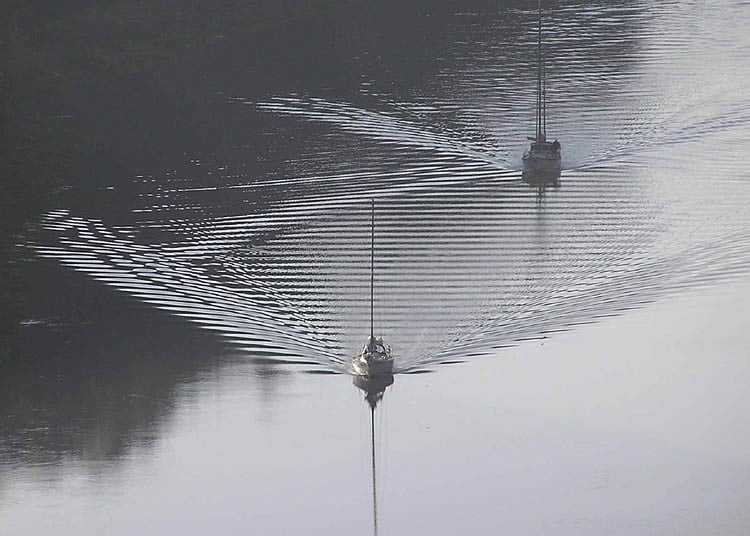
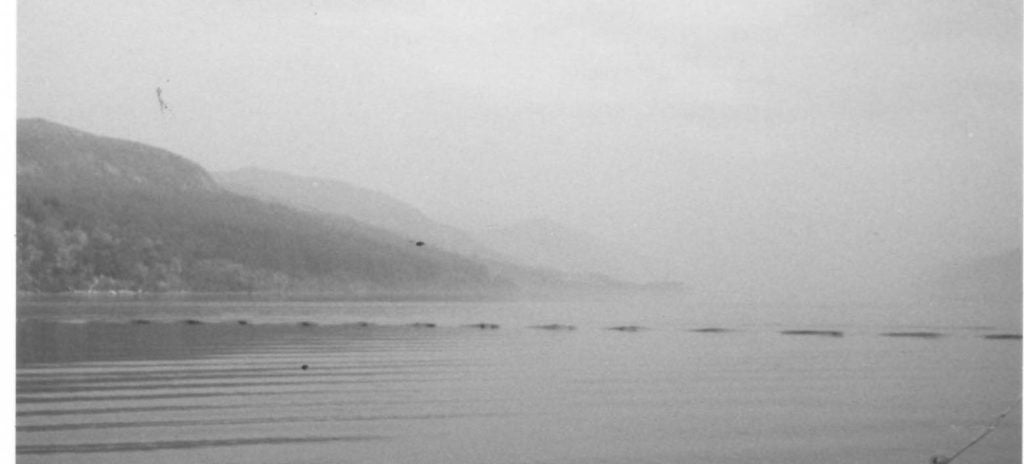
The wavefront of a Kelvin wake is complicated, consisting of a series of waves apparently travelling at an angle to the wake itself. This accounts for the series of peaks in the above photo. They themselves can be mistaken for a ‘monster’.
The above pictures do not show a screw wake, but below is Tim Dinsdale’s picture of what he thought was Nessie. It shows a motor boat, not a large vessel, displaying both Kelvin wake and a screw wake.
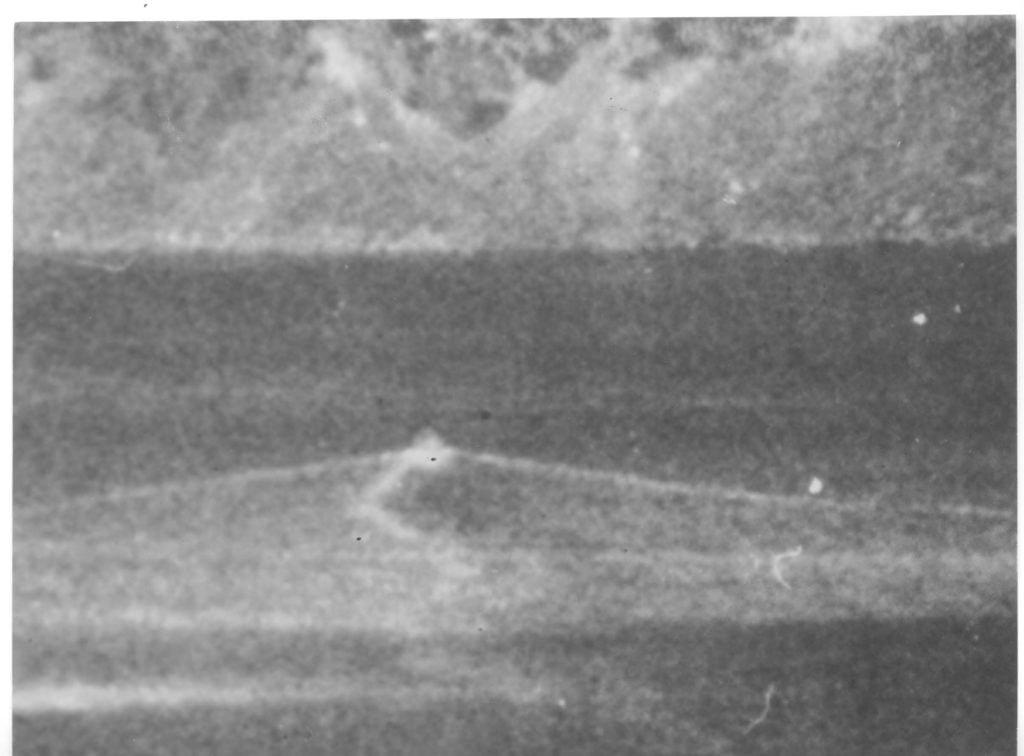
The phenomenon I refer to is caused by the fact that, in such lakes, particularly if they have steep shores, wakes will be reflected back. Loch Ness is a prime example. A reflected Kelvin wake can then, travelling back from the shore as if they themselves came from a vessel, interfere with the vessel’s own wakes, even with the screw wake. The result can be what we might call a ‘standing wave’: a wave maintaining its appearance, appearing to have its own identity and movement as it is continually fed by various wakes. However this phenomenon needs an almost flat calm water surface, in what some call ‘Nessie weather’. Nessie sightings often occur in calm weather, because that is when these wake effects can be seen.
Such an explanation has also been postulated for Ogopogo, the phenomenon of Lake Okanagan in Canada. In calm conditions a wake may travel a great distance. In fact, there is a type of wave called a soliton that travels great distances without losing much energy; it was first noticed on a canal near Edinburgh when a barge stopped suddenly.
When a water wave reaches shallow water, it breaks when the bottom of the energy system is forced up by the shelving bottom. A large vessel can cause a deep wave disturbance that may not be visible until it is forced to break in shallows, at which point a sudden upheaval may occur. Conditions for such upheavals exist at Loch Ness at both ends, as well as in the middle at Urquhart Bay.
One of the major causes of Nessie-like wakes on Loch Ness was British Waterways’ converted ice-breaker tug Scot II, which operated on the Caledonian Canal from 1931. From 1960 to 1991, it carried tourists on cruises according to a strict timetable. It is no longer on the Canal.
‘Standing waves’ through the years
There are many Nessie reports that could reasonably be explained by ‘standing waves’ (I use inverted commas because this term has a different meaning in physics). For example:
- On 24th June, 1933, a squad of workmen engaged on blasting operations near Abriachan on the north shore of Loch Ness were startled to see what they took to be the ‘monster’ going up the centre of the lake in the wake of a passing drifter. They said it had an ‘enormous head and a large heavy body’.
- Alex Campbell, the man who started the Nessie legend, was out rowing in his boat opposite the Horseshoe (Scree) on a ‘beautiful’ (and therefore, we might assume, calm?) summer day in 1955 or 1956 when the boat suddenly started to heave underneath him. He was terrified. The boat seemed to rise and then stagger back almost immediately.
- In 1926, Simon Cameron was watching two gulls skimming the surface near Cherry Island when the gulls suddenly rose screaming into the air. Then something like a large, upturned boat rose from the depths with water cascading down its sides. Just as suddenly, it sank out of sight.
- At around 8.15pm on 22nd July, 1930, three young anglers (one was Ian Milne, who later kept a gunsmith’s shop in Inverness) were fishing in a dead calm of Tor Point near Dores when they heard a great noise and saw much commotion in the water about 600 metres away down the lake (southwards). This commotion, throwing spray up into the air, advanced to within 300 metres of their boat and then seemed to turn aside into the bay above Dores. Their boat rocked violently as a 75 cm-high wave passed. They claimed that, although they detected a wriggling motion, the wash hid the ‘creature’ from view. Milne stated that the object travelled at a speed of 7 metres per second with an undulating motion; he compared it to an enormous conger eel, and was sure that it was neither a seal nor an otter.
- Colonel Patrick Grant was driving north out of Fort Augustus, past Cherry Island, at around midday on 13th November, 1951, when he saw a great disturbance in the water about 150 metres from the shore. About 2 metres of some black object was showing about 30 centimetres out of the water, but as he looked, it disappeared only to reappear a moment later at least 100 metres away and nearer the shore. The speed of movement was very great.
- Just before his retirement, Alex Campbell claimed to have seen Nessie again as he was passing Cherry Island. He saw just one hump about 2.4 metres long and half as high that ‘shot off’ to the other side of the lake at a great speed, leaving a large wash.
- On 31st August, 1979, Muriel Clark and Isobel MacLeod were passing Temple Pier when they noticed a man studying the water through binoculars. On looking across to the Bay, they saw a large disturbance on the surface; huge waves were crashing towards the road. As they stopped the car and got out, they saw ‘a huge head’ and what looked like the coil of a snake, and, below the waterline, the outline of a huge body. They thought that the ‘head’ was flat and parallel to the water, large and snake-like. In only a few seconds, the phenomenon disappeared, going down ‘like a sub-marine’. This was around 4pm.
Complications set in when two wakes intersect; even though the individual wakes may not have been very obvious, when they cross constructive interference can cause an obvious hump of water that will move in a direction different from that of either wake, appearing to make its own wake. Such a hump, after appearing to remain stationary for some time, can suddenly leap forward across the water, giving the impression of a bow wave and following wake. Very impressive ‘monsters’ with one or more humps can be formed and the effect can occur up to half an hour after a boat had passed. In spite of regular traffic through Loch Ness, it was rare enough to take even the most experienced observers by surprise.
British Waterways’ Chief Engineer in Scotland (R B Davenport) had seen Nessie-like wave interference effects on Loch Ness. He noticed that an “eruption of humps” occurred when the outgoing wake of a craft intersected the return wake when the craft turned. It could also occur when the wakes of two different craft, travelling in opposite directions, met. A vessel’s stern wave also causes a “trail of obedient humps which seem to be towed by the vessel”.
Where the shore of Loch Ness is steep, an incoming wake can be reflected back out again, perhaps modulating an incoming wake, “carving it up in a smooth and regular manner”. Two reflections from each shore can converge a long way behind a boat to form “what looks for all the world like the disturbance caused by a partially submerged creature swimming in a straight line”. Davenport also noted that a similar effect was produced close inshore when the shore-reflected bow waves intersected with the incoming stern wave from a large boat. They may be stationary or moving, and they may not appear until the vessel that caused them is out of sight. On one occasion, he saw a steamer’s wash, when it reached the opposite shore, produce an animal-like brown and glistening hump with foam at one end like a lashing tail.
D Mackenzie of Balnain recalled how, when he was on a rock above Abriachan in October of 1871 or 1872, he saw what he took to be a log of wood coming across the lake. The water was very calm. Instead of going towards the river, as he expected, in the middle it suddenly came to life, looking exactly like an upturned boat, and went at great speed, wriggling and churning up the water, towards Urquhart Castle. He was sure that it was an animal of some sort.
On 24th June, 1933, a squad of workmen engaged on blasting operations near Abriachan were startled to see Nessie going up the centre of the lake in the wake of a passing drifter. It had an ‘enormous head’ and a large heavy body.
On 24 August, 1933, three witnesses on the Foyers–Dores road noticed a disturbance on the surface of a very calm Loch Ness just opposite them and a little over half-way across. The disturbance was some 500 metres astern of a drifter steaming towards Inverness. However, since there was calm water between the drifter and the disturbance, they concluded that it could not be the wake. There were several humps in line, rising and falling with a slightly undulating motion, suggesting a caterpillar. The number of humps and their relative size varied, but they maintained the same speed as that drifter. The humps appeared to create their own wake. Later, because they thought they saw it going in the opposite direction, the witnesses concluded that Nessie had turned around underwater. The drifter was later identified as the Grant Hay, none of whose crew saw the disturbance.
On 20 October that same year, in calm, Scot II was towing, about 73 metres astern, a big steel barge (Muriel) from Fort Augustus to Inverness. About 5 kilometres up Loch Ness, when they were travelling at about 5 metres per second, engineer Robert MacConnell noticed a wave-like mound of water moving out from the side of the lake until it came in line behind Muriel. It then followed the boats until MacConnell shouted to the men on Muriel, when it sheared away and disappeared. The ‘mound’ was estimated to be about 2.5 metres long and half a metre high.
Around 30th August, 1938, on a calm Loch Ness, the steam tug Arrow was on her maiden voyage from Leith to Manchester when the captain (Brodie) and mate (Rich) noticed a huge black ‘animal’ rather like a hump-backed whale emerge on the surface and keep pace with the ship at some distance. The object had two distinct humps, one behind the other, but after a brief disappearance it reappeared with seven humps or coils and tore past the tug ‘at a terrific speed’, leaving large waves.
At 3.15 pm on 13th August, 1960, the Revd W L Dobb and his family had just finished a late lunch at an unknown location beside Loch Ness when they saw large waves moving along on a dead calm surface. It was just as if a motorboat was ploughing through the water, but no boat could be seen. A few seconds later, they all saw a large black hump in the middle of the waves, but it quickly disappeared, only to be replaced by two humps.
On the evening of 22 June 1993 near Dores, a ‘long neck and head’ was seen moving about in the water. Edna MacInnes (25) was with her friend David Mackay and her 16-month-old son Arron on the A82 near Abriachan on the other side of the lake. After watching it for about 10 minutes, they drove around to Dores to get a better look. To their surprise the object was still there:
We followed it for about 300 feet [91 m]. There was a terrific wake behind it, then suddenly it dived deep with such a splash and disturbance to the calm waters that we had to jump back from the shore to stop getting soaked by its wake.
The object was also seen by James Macintosh and his 13-year-old son James, already at Dores.
This report is similar to that made by Ian Cameron, reported by Andy Owens on 7th November, 2022, in The Skeptic. On that occasion, there would have been a ship or boat movement further down the lake, probably unseen by Mr Cameron and his companion. He water surface must have been calm.
The Mackay sighting
The seminary report of a monster in Loch Ness appears to have had the same cause. In March 1933, John Mackay and wife, then tenants of the Drumnadrochit Hotel, were driving along the old narrow road near the seven-mile stone, opposite Aldourie Castle at the very northern tip of the lake. Suddenly, Mrs Mackay shouted to her husband to stop and look at an enormous black body rolling up and down. By the time he had stopped the car, all he could see were ripples, but he knew that something “big” was out there, “about a mile and a half [2.5 km] away” (in fact, at that point the lake is only about 1 km wide).
Mrs Mackay caught sight of a violent commotion in the mirror-like surface (sic) around 100m from the shore. The commotion subsided and a big wake became visible, apparently caused by something large moving along just below the surface. This wake went away across the water towards Aldourie Pier. Then, about half way (some 450 m), the cause of the wake emerged, showing as two black humps moving in line, the rear one somewhat larger. They moved forward in a rolling motion like whales or porpoises, but no fins were visible. They rose and sank in an undulating manner. After some time, the object turned sharply to port and, after describing a half circle, sank suddenly with considerable commotion.
This sighting was reported by water bailiff Alex Campbell to the local Inverness Courier, where the editor coined the word ‘monster’ to describe it, and the myth was born.
There are even some photographs which appear to show this ‘standing wave’ phenomenon. On 23rd October, 1958, The Weekly Scotsman, published a photograph (below) and an account sent in by Peter A MacNab, an Ayrshire councillor and bank manager. He took the picture on 29th July, 1955 and explained the delay as being due to ‘diffidence and fear of ridicule’. He wrote:
I was returning from a holiday in the north with my son and pulled the car up on the road just above Urquhart Castle. It was a calm, warm hazy afternoon. I was all ready to take a shot of Urquhart Castle when my attention was held by a movement in the calm water over to the left. Naturally I thought of the ‘Monster’ and hurriedly changed over the standard lens of my Exacta (127) camera to a six-inch [150 mm] telephoto. As I was doing so, a quick glance showed that some black or dark enormous water creature was cruising on the surface. Without a tripod and in a great hurry, I took the shot. I also took a very quick shotwith another camera, a fixed-focus Kodak, before the creature submerged. My son was busy under the bonnet of the car at the time and when he looked in response to my shouts, there werejust ripples on the water. Several cars and a bus stopped, but they could see nothing and listened to my description with patent disbelief.
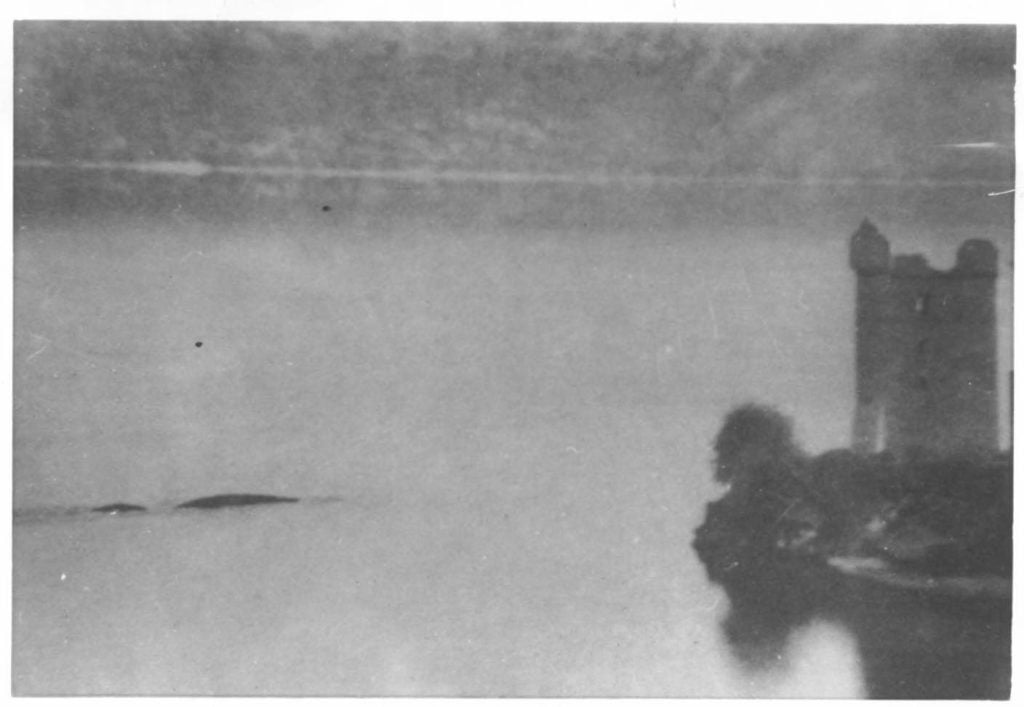
The likely cause was British Waterways’ converted ice-breaker tug Scot II. It always travelled from Inverness to Drumnadrochit and turned in Urquhart Bay.
There are also sketches by eyewitnesses, including the following, which was published in The Scotsman on 13th July, 1960. There must have been a vessel travelling north ahead to create the ‘standing wave’.
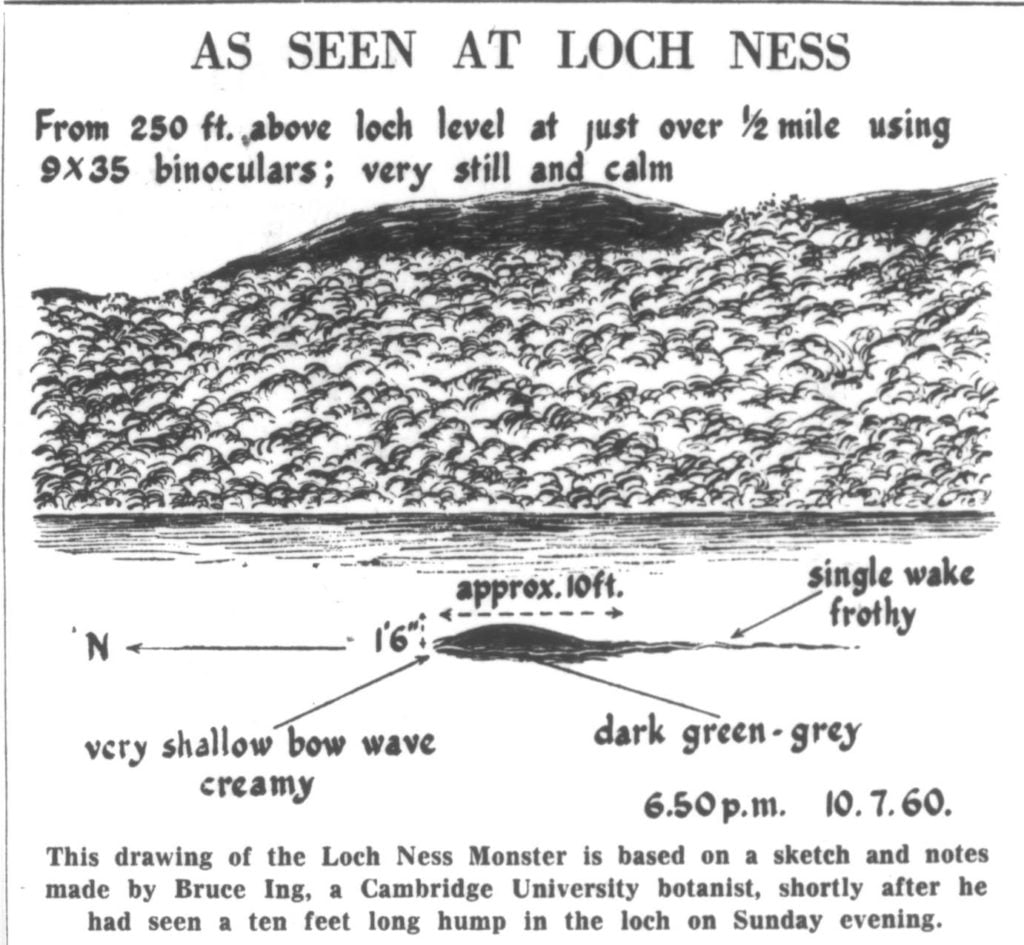
Below is a sketch made by art teacher Alistair Boyd of what he thought was Nessie in Urquhart Bay about 4:15 pm on 30 July 1979. The view is from above Temple Pier.
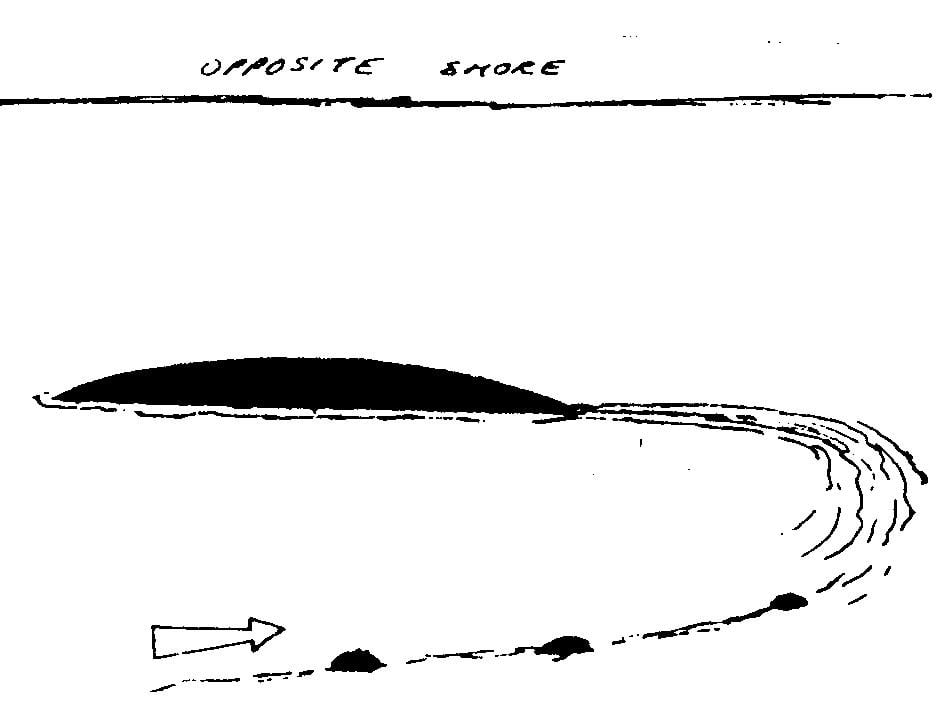
He and his wife noticed a small dark shape appear and disappear three times very quickly. It moved into the Bay about 150 metres from the shore then seemed to churn about in a left turn and surface a little further away, looking like the top of a huge tyre inner tube. It was visible for about 5 seconds. The cause seems likely to have been Scot II, which would have been in the Bay at around 4pm, turning for its return to Inverness.
It is understandable that, to people who are not aware of this wave phenomenon, such a sight would be interpreted to be convincing evidence of the existence of Nessie. Lacking knowledge, the human brain comes to the best conclusion known and can create features to make the image fit with preconceptions. The phenomenon is probably responsible for the majority of Nessie reports. It should be more widely known, especially by sceptics.
Most of the eyewitness reports above are from my book The Loch Ness Monster: The Evidence, last published in 2002 by Birlinn. It is now out-of-print but some copies are available on the internet.


